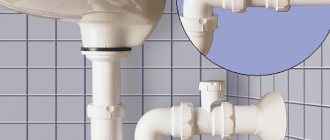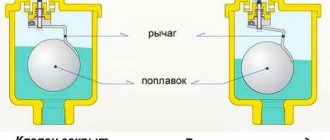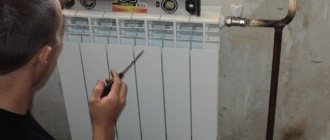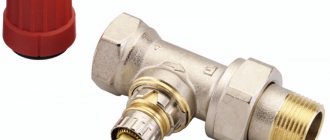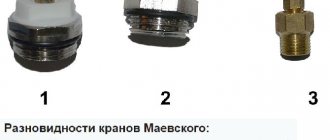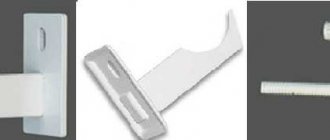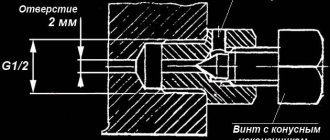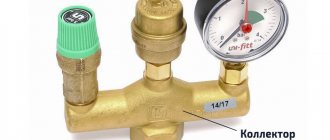Only automatic releases cut directly into the pipeline, but not manual ones. Mayevsky's tap is not capable of capturing air bubbles, since it does not have a corresponding chamber, so they are designed for installation on heat exchangers.
Knowing where to place automatic air releases, you can check the correct location of these products. If your system has a Mayevsky valve installed on the pipeline, then this placement is incorrect. If the size of the automatic device spoils the design appearance of the radiator and the room as a whole, then you can replace them with special mini-graduates.
Installation of an automatic air vent for air release
A characteristic feature of heating systems using liquid coolant is the appearance of air pockets. Many people who use this type of heating face this problem. In open circuits, air leaves naturally, but for closed circuits it is necessary to use a special device to help get rid of gas contamination. Such a device is an automatic air vent. Air has a negative impact on the operation and service life of the heating system. Gradually, a corrosion process occurs due to the reaction of iron with oxygen. Also, the plugs do not allow the coolant to move normally along the circuit, which leads to weak heating of individual elements of the system. The occurrence of bubbles entails premature failure of even the highest quality circulation pumps. There are several main reasons why air locks appear:
- 1. For the coolant, ordinary tap water is used, which has not undergone processing steps that help remove dissolved oxygen. During heating, it again acquires gaseous form and accumulates at the turning or upper points of the heating system.
- 2. Very fast filling of the pipeline with liquid.
- 3. The coolant supply is not from the lowest point. This prevents water from displacing all the air from the system.
- 4. Leaks or damage to connecting elements.
- 5. Using pipes that are not designed for hot water.
- 6. Errors during system design.
- 7. Installing the radiator without observing the required angle of inclination.
- 8. Accidental air intrusion during repairs.
If plugs constantly appear in the same place, it is recommended to install an automatic air bleeder for the heating system. This will solve the problem with lowering pressure.
Air bubbles in the liquid usually accumulate in certain places in the pipeline or inside the batteries. The resulting plug gradually increases, which leads to partial or complete blocking of the circulation of hot water in a particular area. Some sections or entire radiators may stop heating completely. To get rid of air in the heating system, two types of air bleeders are used:
- mechanical Mayevsky valve;
- automatic air vent from the heating system.
During the Soviet Union, air separators of this kind were not used. In private buildings, open-type heating was usually used. In this case, the air came out through the expander. Centralized networks were supplied with air vent valves. They were often mounted at the highest points.
The design of a mechanical air deaerator is quite simple. It often has a brass body and ½ or ¾ threaded connections. inches There is a small hole on the side of the device, which is necessary to bleed air from the system.
Some models of mechanisms are equipped with a special plastic insert. There is a small outlet channel inside it. This allows you to operate the device with greater convenience, since its position can be adjusted thanks to a plastic washer . The mechanical vent functions as follows:
- 1. When operating heating systems, the screw from this device is tightened and completely covers the outlet.
- 2. If it becomes necessary to release the accumulated air accumulations, then unscrew the screw a little. The pressure of the coolant squeezes out the plug.
- 3. First, clean air comes out of the radiator, and then mixed with liquid. The Mayevsky valve closes only after water begins to flow from the hole.
Mayevsky's manual crane is able to work correctly for many years. This trouble-free device has a long service life.
Often the device is mounted on a radiator. Mayevsky taps have different ways of unscrewing. For this purpose, you can use a plastic or metal handle, a regular screwdriver or a four-sided wrench.
The automatic air vent can be used for both heating and hot water supply systems. Such a device operates without any human intervention. The mechanism consists of a brass body and a barrel located vertically, and has threaded connections. There is a plastic float inside the device. A valve is connected to it, which is exposed to water. The operating principle of an automatic air vent for heating is as follows:
- 1. When the chamber is in working condition, the body is filled with water, which puts pressure on the float and presses it up. The air valve is closed.
- 2. As air accumulates in this chamber, the liquid level begins to decrease. The float gradually lowers.
- 3. When the amount of water critically decreases, the valve opens, which leads to the release of accumulated air to the outside.
- 4. After complete displacement, the entire mechanism returns to its previous position. The valve closes again.
When the heating system fills with liquid, air is constantly released until the float rises to the top of the chamber. After filling the tank with water, the spring begins to act on the valve, and it closes the hole.
Automatic gas vents can be with angular or direct connection. Some manufacturers make the design so that the discharge occurs vertically, while others - to the side. For normal household use, such differences have virtually no significance.
Companies producing self-releasers are constantly improving their products. Leading companies provide products with some additional functions, which include:
- 1. Protect the device from water hammer. To do this, a reflective plate is added to the design.
- 2. Additional horizontal fittings. They serve to more effectively collect small air bubbles.
- 3. The mini-valve can be installed directly into the radiator plug.
Also, some models allow you to dismantle the valve without draining water from the system. This is possible thanks to the built-in shut-off valve. When unscrewing the element, the spring begins to straighten and presses the gasket against the radiator inlet.
In any heating system using liquid coolant, there are certain areas where it is imperative to install an automatic drain. Mechanical Mayevsky valves should be installed on all radiators so that it is always possible to bleed off excess air. The automatic device should be installed only in a vertical position in the following wiring areas:
- 1. To the safety group of a heat generator connected to a closed heating system.
- 2. On all heating collectors made like underfloor heating.
- 3. At the highest point of the contour.
- 4. On the heated towel rail.
- 5. In all distribution combs.
- 6. It is advisable to mount the device in a hydraulic arrow.
Also, these devices are installed at all problem points of the network, especially where U-shaped loops appear that are turned upward. In such places, air jams cannot be avoided.
When it comes to mechanical valves, they should not be installed directly into pipes. This way the air will pass by the device, and instead of the plug the coolant will come out. In this case, the device is completely useless. Automatic air vents are equipped with a special chamber that catches all bubbles. The best option would be to install a corner mechanism. Many people refuse such a device because the flask is very noticeable. To keep the tank out of the way, you can take a mini-model of the sump.
The most important recommendation is that you should not buy valves made in China. Almost all models of this origin are of dubious quality. The consequences of such savings can lead to the following:
- 1. In parallel with the air pockets, the device will leak liquid. This leads to a drop in pressure in the circuit, as well as to the appearance of leaks on the body, walls and floor.
- 2. A poor quality air vent may simply not work.
- 3. The coolant quickly renders all structural elements of the valve unusable.
With mechanical devices, this problem occurs much less frequently, since there is practically nothing to break in their design. These products are not some kind of complex equipment, so their cost is quite low. Even well-known manufacturers (for example, Valtec) provide products at an average price. Spirotech machines are also famous for their high quality characteristics. Basic tips for choosing:
Features of choosing air vents
Not everyone knows where to start choosing an automatic air vent. In order for the product to serve for a long time and without failure, it is recommended to buy products of European or domestic production, but not cheap Chinese counterfeits. Buying a cheap automatic graduate can cause the following adverse consequences:
- Passing not only air, but also coolant through the valve. In this case, a puddle of water will be detected under the radiators or in the places where the air vents are installed.
- Rapid deterioration.
The product is jammed, so it will not work.
Although automatic type safety valves have a shorter service life than manual ones, they must serve without fail for at least 10 years. Manual products have a service life of over 15 years, so instead of buying a cheap machine, it is better to give preference to a manual device. This will allow you to win not only in terms of savings, but there will also be no problems with air bleeding.
To choose good quality Mayevsky uranium, you need to pay attention to the following criteria:
- The presence of a handle allows you to conveniently open the valve for bleeding air. The disadvantage of faucets with handles is that they can be accessed by children, who are quite capable of opening them. Installation of such outlets with handles is appropriate only in hard-to-reach places; in other cases, it is recommended to install conventional products with a key or a screwdriver.
- To avoid losing the special bleeder key, it should be placed on the wall next to the radiator. This will prevent you from losing the key, and will also allow you to quickly bleed the air.
- Buy products with anodized coating. This spraying allows you to protect the metal from the occurrence of oxidative processes.
- If your budget allows, you can purchase a product that can trap air bubbles. However, such manual air vents do not differ much in cost from automatic air vents.
In order not to make a mistake with your choice, you need to pay attention to the manufacturer. Depending on the brand of plumbing and heating equipment, not only the quality, but also the cost will differ. In addition, if a closed heating system is used, then you need to pay attention to the technical parameters of the devices, in particular, operating pressure.
In addition to the familiar Mayevsky taps, modern heating systems commonly use a device such as an automatic air vent. Its task is to remove air from a certain section of the heating network without human intervention. How this important device works, the principle of its operation and its installation location - all these nuances will be discussed in this article.
How does an automatic air vent DN15 (1/2) work in a heating system?
The presence of air in the heating system is extremely undesirable. However, he gets there one way or another. This has a very detrimental effect on the quality of operation of the heating system as a whole and reduces the service life of its individual components. In order to remove accumulated air, an automatic air vent is needed.
In this article we will talk in detail about this device, the principle of its operation, marking features and popular models, as well as how to properly install it in the heating system.
Air in the heating system - why is it bad?
It would seem that the heating system is closed, completely filled with coolant, where does the air come from? There are several ways for it to appear inside, among them there are several main ones:
While filling with coolant
While you fill the heating system with water or other coolant, it mixes with air. It is almost impossible to avoid this, so you have to take it for granted.
Through poor connections
Poor installation of the heating system, installation and connection of a solid fuel boiler or other heating device, poor quality, defective or broken shut-off valves or other elements - all this leads to air penetration inside.
Chemical reactions
In addition to air, other gases can accumulate inside. For example, if you use a coolant with high acidity and aluminum radiators, hydrogen will be released as a result of a chemical reaction.
Photo 1: Automatic air vent for heating systems
As you can see, there are many reasons for this phenomenon. But why is this so bad? The first thing this leads to is cavitation. It significantly accelerates the wear of equipment and leads to noise during its operation. The second reason is corrosion. It destroys the elements of the heating system and carries their particles with the coolant flow to other devices, clogging and interfering with their normal functioning. Thirdly, the presence of air reduces the actual heat transfer of heating devices and leads to disruption of the pumps. It can even cause a rupture of the boiler casing.
To eliminate all these problems, an automatic air vent is used. Let's figure out how it works in the heating system and what components it consists of.
Return to contents
Air vents for heating systems - operating principle
To bleed air from the circuit, you can use a regular valve by draining a certain amount of liquid. If in communal houses a decrease in the volume of water in the circuit does not cause negative consequences and it is replenished by utility services, then in individual houses the drained coolant will have to be replenished independently.
For a closed system, adding coolant is quite a big problem - you will have to connect a manual or electric pump, and if there is toxic ethylene glycol antifreeze in the line, carrying out the work while taking the necessary safety measures will take a lot of time.
The main difference between special air vent devices and conventional valve locks is the small diameter of the outlet hole, its location at an angle of 90 degrees and the ability to smoothly adjust the cross-section of the outlet channel with a threaded screw.
As can be seen from Fig. 2, the screw has a cone-shaped shape and a similar seat, thanks to which, when closed, it reliably and hermetically covers the inlet hole. To bleed air, the screw head is turned one or two turns, opening a small-diameter outlet drain hole, and the air-filled coolant along with bubbles will begin to flow out of the tap in small quantities while the air plug will be released more intensively.
The advantage of using an air vent is that when you turn the screw, first of all, with a characteristic hissing sound, the air flow comes out, and then the aired coolant flows out, a small amount of which does not need to be added to the system.
Fig.3 Operating principle of an automatic air vent
Design and principle of operation of an automatic air vent
The design of this small device is very simple. Inside the brass body there is a polypropylene float which is connected via a rocker arm to the spool. As the body fills with air, the float moves down and opens the exhaust valve. The freed space is filled with water and the rising float closes the spool. To prevent various debris, dust and dirt, from getting inside the spool, its outlet hole is closed with a plastic cap.
Photo 2: Design of an automatic float-type air vent
There are models with a slightly different implementation of this process, but in general it is always the same: when the float is down, the valve is open and releases air; if it is raised, the spool closes and the device accumulates gas again. This cycle is repeated again and again automatically.
Return to contents
Types and markings, popular models
There are several types of automatic air vents. All of them are divided into two large types: automatic and manual air vents for radiators or Mayevsky taps.
Depending on the diameter of the threaded connection, they are of two types: 1/2 and 3/4 inches. The first is better known by Russian markings as an automatic air vent valve Du 15, the second - Du 20.
According to the method of fastening, they are divided into classic straight and lateral. For air vents of the second type, the threaded connection is rotated 90 degrees. The air release valve may also be located on the top or side. Various modifications are produced by the manufacturer to facilitate installation in difficult places in the heating system or for mounting on the side of radiators.
Photo 3: Automatic air vent DN15 “Valtec” VT 502 with shut-off valve
In the domestic market, the two most famous are Danfoss. supplies the Russian market with an automatic air vent VT.502 with a mounting diameter of 1/2 (DN15). The model has proven itself well and is very popular among installers of autonomous heating systems in private homes. It has a brass body coated with a layer of nickel, which is designed for a maximum pressure of 10 bar and a temperature of 110 °C. The average price at which you can currently buy this model is 280 rubles.
Photo 4: Automatic air vents 1/2 "Danfoss" series "Eagle" and "Wind"
Takes second place. It produces automatic air vents in two series: “Eagle” and “Wind”. Despite the general technical characteristics, they differ only slightly in appearance. The models are made in brass cases and are designed for a maximum pressure of 10 bar and a temperature of 120 °C. In addition to the standard mounting thread DN15 (1/2), Danfoss also produces automatic air vents with fastening 3/8 (DN10). Prices for these devices are also within 300 rubles.
Return to contents
Types of air vents and their design features
There are air vent valves of automatic and manual operating principles, the former are mainly installed at the top points of collectors and pipelines, manual modifications (Mayevsky valves) are placed on radiator heat exchangers.
Automatic devices are distinguished by a wide variety of designs for locking mechanisms; their cost is in the range of 3 - 6 USD; the market offers a wide range of models from domestic and foreign manufacturers. The cost of standard Mayevsky taps is about 1 USD; there are products at a higher price, designed to function in non-standard radiator heaters.
Rice. 6 Air vents for heating systems with a rocker mechanism
Automatic
Automatic tappers have different designs depending on the manufacturer; the main differences between the devices are:
- The presence of a reflective plate inside the body. It is placed at the entrance to the working chamber, protecting internal parts from hydraulic shocks.
- Many modifications are supplied complete with a spring shut-off valve into which the air vent is screwed; when it is removed, the spring is compressed and the O-ring closes the outlet channel.
- Some models of automatic diverters are designed for operation in conjunction with radiator heat exchangers; instead of straight ones, they have side threaded pipes of the appropriate size for screwing into the radiator inlet. If necessary, corner automatic air vents of any type can be used, for example, at the connection points of heated floor circuits, hydraulic arrows, if their threaded diameters of the inlet and outlet fittings match.
- There are analogues of air vents on the market - microbubble separators; they are mounted sequentially in the pipeline on two inlet pipes corresponding to the diameter of the pipes. When liquid passes through the body tube with a soldered copper mesh, a vortex water flow is created, which inhibits the dissolved air - this promotes the rise of tiny air bubbles, which are released through the automatic air release valve of the chamber.
- Another common design (an example of the first was given above) is a model with a rocker mechanism. In the chamber of the device there is a float made of plastic; it is connected to a nipple locking needle (like a car one). When the float is lowered in an airy environment, the nipple needle opens the drain hole and air is released; when the water rises and the float rises, the needle closes the outlet.
Rice. 7 Operating principle of separator-type air vents for bleeding microbubbles
Manual
Manual devices for removing air from the system are called Mayevsky valves; due to the simplicity of their design, mechanical air vents are universally installed on radiators. On the market you can find manual taps in a traditional design for installation in various places, and some modifications of shut-off valves are equipped with Mayevsky taps.
The Mayevsky cranes produced do not differ in a wide variety due to their simple design, consisting of a body with an air duct bent at 90 degrees and a cone-shaped locking screw.
A mechanical vent for removing air from a heating system works as follows:
- In operating mode, the conical screw is tightened and reliably seals the outlet hole of the housing.
- When it is necessary to remove excess air from the battery, make one or two turns of the screw - as a result, the air flow under coolant pressure will come out of the side hole.
- After the air is released, the water begins to bleed out; as soon as the water stream becomes intact, the screw is screwed in again and the de-airing operation is considered complete.
Installation in a heating system
Small air bubbles traveling through the heating system are collected into larger ones, which rise higher in the heating system. It is for this reason that it is recommended to install automatic air vents at the highest points of the heating system. The most susceptible to the formation of air locks are water heating boilers, collectors, radiators and other U-shaped areas, which are also equipped with these devices. Automatic or manual air vents for radiators are installed in residential premises, and heating boilers are protected by special safety groups for heating boilers.
Photo 5: Installation of an air vent as part of a safety group
To avoid draining the coolant from the heating system when dismantling the air vent for repair or replacement, a shut-off valve is installed in front of it. It consists of a brass body with a plastic spool inside. The shut-off valve is open when the air vent is screwed into it. When unscrewed, the valve automatically closes, isolating the heating system.
In addition to our story, watch a short video about automatic air vents:
The automatic air vent is an extremely important element of the heating system. Despite its small dimensions and simple design, it reliably protects the system from the destructive effects of air. The correct selection and installation of this cheap device will save you significant money on repairing expensive components of your home’s heating system.
Where should air vents for heating systems be installed correctly?
When installing a heating system, installing air vents is a mandatory procedure; to determine the required quantity, you need to know where to place these devices. Air vents are recommended to be located in the following places:
- The highest points of the system. If during installation the pipeline rises upward, bypassing any obstacle, and then descends down to the heat exchangers, an automatic air vent for the heating system should be installed on top. This will prevent airing due to the fact that light air always rises and accumulates in the pipeline on the upper floor.
Rice. 9 Types of automatic air vents
- Heating radiators. Radiator heat exchangers have a complex shape, including a large number of sections - this creates convenient cavities for air accumulation. Therefore, Mayevsky outlet valves are always used in radiators; in an individual heating circuit, they are installed on each radiator, regardless of the connection diagram (one-pipe, two-pipe, bottom, side, diagonal). Radiator manual models of exhaust valves, unlike automatic ones, are small in size, less expensive, fit aesthetically into the radiator contour, and therefore are installed on batteries in the vast majority of cases by the manufacturer and, if necessary, by home owners.
- Heated towel rails. Industrially produced heated towel rails of the complex “ladder” shape, popular in everyday life, are always equipped with an air vent with a straight pipe located in its upper part. It is more convenient if the heated towel rail is equipped with an automatic air vent for the following reasons: the screw located at the top of the manual model is inconvenient to tighten, in residential buildings there may be periodic lack of water and manual adjustment becomes troublesome, in addition, the duct protruding from the side spoils the aesthetic appearance of the heater.
- U-shaped bends and bypasses. Any section of a pipeline with an upward-facing loop collects air; if a shut-off valve is used to turn off the loop, it is installed at the highest point, using a model with a built-in automatic Mayevsky valve (naturally, the air vent at the top can be installed separately from the valve).
- Boiler piping system. It is also recommended to equip the boiler piping with a valve to ensure safe operation of the heating equipment in the event of airing in the main line.
- Hydroshooters. It is not so often that in household heating systems they use hydraulic arrows, to which circulation pumps, radiator and heated floor collectors are connected - if the device is located vertically, an automatic air bleeder is screwed into its upper part.
- Collectors. When installing multi-circuit heated floors, manifolds with combs are used, to which the pipeline of various circuits is connected. The collectors are located above the level of the water floors and are always equipped with automatic air vents, which are installed in their housing by the manufacturer; the system includes two devices for the supply and return lines.
Rice. 10 Manual and automatic air vents for heating systems - location diagram
Why is air in a heating system dangerous?
When air appears in the heating system, a plug forms. This causes one part of the pipeline to remain cold and another to overheat. When air from all heating circuits accumulates in one place, the movement of the coolant completely stops. What does this mean:
- When an air block appears in a closed circuit, pressure increases in the system. Because of this, the safety valve is activated.
- It will constantly operate and remove water from the system until the heating equipment burns out.
- Sometimes pipes burst due to this pressure.
To prevent this and eliminate the problem, install an air vent. In addition to these difficulties, the presence of air in the circuit will lead to oxidation of the pipe, rust and a decrease in service life.
The automatic air vent is divided into the following main types:
1. Permanent air vent. Fig. 1. This means that the automatic air vent removes air and gases constantly in a filled system. It is characterized by high reliability, relatively low throughput and, as a rule, works both for air intake and exhaust. These are models for both domestic and industrial use, for example on risers of residential buildings.
2. Starting air vent. Fig. 2. Used to quickly remove air when filling systems, then it closes and does not remove air. An automatic air vent of this type can operate only to release air, or to release and start while the system is draining. As a rule, these air vents are used only on water systems with temperatures up to 60C.
3. Combined action air vent. Fig. 3. This automatic air vent in its design has 2 floats - a large one for starting or emptying the system and allowing a large amount of air to pass through, and a small one for operating the valve when the system is already filled. Such valves are mainly used in water supply and sewerage systems, much less often in heating systems.
Causes and consequences of air locks in an open heating system with natural circulation
If the pipe slopes in the system are correctly designed, then all the air will be released through the open expansion tank, which is located at the top point of the heating circuit. There can be several reasons for an air lock:
- After repairs, air remained in the heating radiators;
- Incorrect (too fast) filling of the system at startup;
- The circuit is filled with water through an expansion tank;
- When heated, air begins to be released from the water, which was previously in a dissolved state;
- When filling the circuit, water was supplied from above.
The consequences are not difficult to predict - stopping circulation, cold batteries, rapid corrosion of the internal surface of system elements. To avoid this, it is enough to install manual air vents on all radiators - Mayevsky taps.
Review of manufacturers
Automatic air vents for gas release are:
- brass with a polyethylene float that is not subject to oxidation;
- cast iron with epoxy coating;
- brass with nickel coating and polyethylene float;
- made of stainless steel.
Among the companies producing automatic air vents for heating systems, the following brands have gained a good reputation.
- Flamco company from the Netherlands. It produces Flexvent domestic air vent valves. The body of the parts is made of brass; the products are mounted in circuits with a small amount of air masses. Mainly intended for batteries.
- The Portuguese company Adca specializes in valves for the industrial segment and heating circuits. The products are made exclusively from stainless steel and are installed in heating circuits with a maximum coolant temperature of no more than 300 degrees.
- Mankenberg produces high quality air vents. The main difference between air vents from this manufacturer is the ability to be installed in heating systems with various types of coolants, even aggressive ones. Air vents are made of stainless steel.
- produces air bleed valves mounted on water supply, heating and sewage systems. Russian-made devices are currently manufactured for heat supply systems - the KAT12 series, water and sewer circuits - the KAT50 series.
- Armstrong is considered the most sought-after manufacturer of high-end automatic air vents throughout the world.
Where are air vents installed?
In a closed system, when installing a device for effective gas removal, certain rules must be observed:
- The pipes are laid so that the vectors of movement of water and air coincide, and the hot liquid is directed from the main riser to distant ones.
- The air collector must be mounted at the highest point, for example, when going around a doorway from above, since air is released from the liquid at low water speed.
- Devices for removing air should be placed in areas where gas accumulation is guaranteed: at turns of risers, in places where pipes change to another cross-sectional size, on all batteries, separators, and combs.
It is mandatory that air vents are mounted on aluminum radiators, which release hydrogen upon contact with the coolant. For partially bimetallic batteries, the problem is not so urgent, but they do contain aluminum, which means that gas will have to be removed, although not so often. There is no aluminum in 100% bimetallic models, but manufacturers strongly recommend using them together with devices for bleeding air.
Operating instructions
- Modern models of devices are equipped with elastic gaskets so that the connection to the radiator and pipeline is elastic and reliable.
- If the presence of a gasket is not enough, plumbing thread is wound at the joint or linen tow and putty are used.
- Installation is available without inviting a plumber. To connect to the system, just use an adjustable wrench.
- Experienced plumbers recommend installing an automatic air vent, the operating principle of which involves effective bleeding of air, not from the blind radiator plug, but on the inlet pipe - between the radiator and the tap.
Video: installation of an air vent
Set it and forget it: is that true?
The Smart Home system implies the presence of various devices that create comfortable living in the house. The monitoring device periodically requires attention, despite its autonomous operation. Over time, the air vent begins to bleed not only air, but also water. The needle valve stops opening and closing independently due to the jamming of the polymer resin float. The light weight and soft texture of the core make it vulnerable to the slightest ingress of debris and hard abrasive particles.
If left unattended, this may cause flooding.
How to disassemble
It often happens when using automatic air vents that they begin to leak. In this case, plaque and mechanical deposits appear on the needle-type valve. In this case, the tap closes completely, the coolant flows out, that is, the tap is leaking. It is necessary to dismantle the device, disassemble it, clean the needle itself, the seat and other disassembled parts with a soft tool. With good cleaning, you may not notice such problems until the next time precipitation occurs. To assemble the air vent, it is recommended to use FUM tape as a thread seal, and the body is screwed in by hand.
Design and operating principle of manual air valve
The needle manual air valve is also called a Mayevsky valve. His device:
- Brass body (plug) with external thread 1/2// or 3/4// for connection to the radiator. The case has two holes for air release Ø 2 mm - one at the end of the case, the second on the side wall;
- Brass locking screw. On one side of the screw there is a groove for a slotted screwdriver, on the other side the screw is machined into a cone that closes the air hole (the “closed” position);
- Plastic casing.
On sale you can find the so-called “faucet at hand”. To use it, you don’t need a key or a screwdriver—the plug can be easily unscrewed by hand.
To remove air from the housing, you need to unscrew the screw. To do this, you can, of course, use a screwdriver, but there are special keys that are most often included. After several revolutions, the screw cone comes out of the end hole and air enters the housing cavity, which is immediately released through the second side hole. The main thing is not to rush to turn off the tap. About 30 - 40% of the air should come out with water, so you need to stock up on time, a basin and rags. After the air has been released, the lost water must be added to the system.
Installation
Modern aluminum or bimetallic heating radiators already have a hole for installing a Mayevsky tap. It can be found on the side opposite the coolant supply, from above. Most likely, there is already a nut for installation there. There is a plastic plug screwed into it. After its removal, an air valve is installed in this place. Before this, the tap threads must be sealed with a rubber or silicone gasket.
Installing a Mayevsky crane on a cast iron battery is much more difficult. Let's start with the fact that these valves are much more powerful than those on aluminum radiators - they can withstand pressures of up to 16 atmospheres and temperatures of 150 C°. Sequencing:
- Drain the water from the radiator;
- Cut a hole in the top plug of the cast iron battery and cut a thread that matches the external thread of the air vent;
- Screw in the Mayevsky tap;
- Add water to the system.
Malfunctions and ways to eliminate them
If the faucet malfunctions, a leak appears. There may be several reasons for this:
- Manufacturing defects. One in fifty taps does not hold pressure at all. The only way out is replacement;
- The screw is too short. In this case, its conical part cannot completely block the hole, so you need to apply a certain force to screw the screw in until it stops;
- Solid particles of debris falling between the screw and the housing can damage the internal threads. Fum tape can help here once, but later you will still have to change the tap.
Causes and consequences of air locks in a closed heating system with forced circulation
The reasons are the same as for an open system, plus:
- A loose circulation pump impeller can “grab” air during operation;
- If hot water is supplied to the expansion tank from above, then air can enter the system through cracks or breaks in the tank membrane.
An air lock in a closed circuit will lead to increased pressure in the system and activation of the safety valve. The valve will bleed water over and over again until the boiler burns out or the heating pipes rupture. Therefore, security requirements for closed systems are much stricter. In particular, for air release, the closed circuit is equipped not only with manual Mayevsky valves, but also with automatic air vents. One of these automatic valves is included in the safety group. The group is placed on the water supply, immediately after the boiler.
Types of Automatic Air Valves
Based on their design, devices can be divided into 3 types:
Note. Despite external differences and different areas of application, the principle of operation of the air vent remains unchanged.
The most common are traditional devices with a direct connection pipe. The scope of their application is very wide. Automatic air separators are primarily designed to release air through the highest points of the pipeline network. To do this, they are placed at the very top of vertical risers, where, according to the laws of physics, all air accumulations that appear in the pipes tend to fall. If it were not for the automatic air vents in the heating system, it would have been very difficult to manually release air from the highest points.
Closed heating systems under pressure are equipped with boiler safety groups, which are located on the supply pipeline leaving the heat generator. Along with the safety valve and pressure gauge, this group also includes an automatic air valve. Its task is to bleed air when the boiler tank is filled with water. If the piping of the unit is done prudently, then, if necessary, it can always be cut off from the rest of the system and emptied using an air vent, and refilled after servicing.
Note. Safety groups for heating must be installed on boilers that burn solid fuel.
Air vent devices are also used in some models of circulation pumps. The goal is to ensure uninterrupted operation of the pumping unit. The fact is that the pump can only move an incompressible medium - water or other liquid. The entry of air into the area of the unit's impeller threatens to completely stop the circulation of the coolant, which is what the air vent of the circulation pump is designed to prevent. Any air or steam from the boiler that enters this area will be immediately released and the pump will continue to operate.
Automatic air vent: design, operating principle, installation
The presence of air and microbubbles in the heating system leads to a decrease in efficiency and disruptions in its operation:
Automatic air vent, max. temperature 110 °C, 10 bar.
- The heat output of radiators is reduced. Air fills the top of the radiator, causing it to become cold;
- Oxygen present in the air contributes to corrosion of the internal walls of equipment;
- Coolant circulation decreases or completely stops;
- The blades and bearings of a circulation pump with a wet rotor are subject to increased load, as a result of which the pump may fail prematurely;
- There is constant noise in the radiators, pipes and circulation pump.
One of the most effective devices that can solve all of the above problems is an automatic air vent - a device designed to automatically bleed air from the heating system.
Consequences of the absence of an air vent in heating
The functioning of the heating complex is based on the circulation of the medium in the pipeline and the transfer of part of the heat to heating devices. The latter, in turn, share this heat with the room in which they are located. An air plug formed in a pipeline or in a radiator (airing) leads to a disruption of the entire process: the circulation of the coolant becomes difficult or stops completely. What else is fraught with the absence of automatic air vents in the heating circuit?
- noisy movement of the carrier in pipes, vibration, increased likelihood of destruction at soldering points;
- airing in remote sections of the pipeline, in areas where the temperature regime is not constantly monitored, can cause a stop in circulation through some radiators. In some cases, this can lead to defrosting of the entire heating complex;
- reduction in the efficiency of heat supply and excessive consumption of heating raw materials;
- failure of radiators caused by corrosion. Corrosion occurs as a result of air entering the internal walls of the batteries.
Automatic air vents are the same necessary components of the heating system as heating devices, pipes and a heat generator. Automated devices enable the heating complex to function fully and maintain all other elements of the circuit in operating condition.
Automatic air vent device
Design and principle of operation of an automatic air vent valve.
An automatic air vent is a sealed brass body, usually cylindrical or cone-shaped. The body contains a hollow float made of polypropylene or high-quality Teflon, which is connected by means of a lever to the drain valve. The drain valve is equipped with a plastic locking cap-plug, which prevents coolant leakage in the event of a device breakdown.
Types of automatic vent valves.
There are 3 types of automatic air vents:
- Direct traditional (installation is carried out vertically);
- Angled (at an angle of 90°). They are used as radiator valves instead of a Mayevsky tap or in cases where the design of the heating system does not allow the use of a direct air vent;
- Special air vents for radiators.
Corner and radiator air vents
In different heating systems, many situations may arise when it is necessary to remove air pockets in the most inaccessible or remote places. It is impossible to list them all, as there are too many options. Where it is not possible to install a simple valve because the threaded pipe at the end is in a horizontal position, an angled air vent will do. Its pipe, coming out from the bottom, turns at an angle of 90º and can be connected to a horizontal section.
It should be noted that an angular air vent with an external threaded connection is no different from a conventional straight valve except for a rotated pipe and can be used instead of it if necessary.
Often, to automatically bleed air from batteries, instead of the traditional Mayevsky tap, some users install an angle valve. This can be relevant in an unpleasant set of circumstances, when gases are constantly formed in the network and this happens precisely in radiators. The reason is a chemical reaction of substances sometimes present in water with the aluminum alloy of batteries at elevated temperatures. There is no point in installing a valve with an angle pipe, because there is a special automatic air vent for radiators, shown in the photo:
These devices are designed for batteries only and have a suitable threaded connection. Instead of manual taps, it is preferable to place them on heaters made of aluminum or partially bimetallic, where there is also contact between the alloy and water. In other situations, the radiator air vent is mounted at will, but there is no doubt that it will bring ease of use.
Note. It is still better to equip traditional cast-iron batteries included in the centralized heating network with a Mayevsky manual tap and drain pipe.
For ease of maintenance and cleaning, complete devices are available for sale - automatic air vents with a valve. The latter is a small threaded adapter with a spring-loaded petal valve inside. The adapter is screwed onto the thread directly in front of the air vent and serves so that when the system is in operation, it can be removed and cleaned or replaced. Air vents from DANFOSS, VALTEK and many other well-known brands are equipped with similar adapters.

